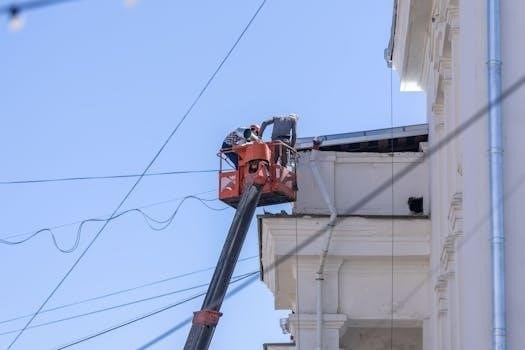Overhead crane inspection is vital for safety and operational efficiency. Regular checks, using a checklist, help identify potential hazards. These inspections ensure that cranes function correctly, preventing accidents and extending equipment life.
Importance of Regular Inspections
Regular overhead crane inspections are crucial for maintaining a safe work environment and preventing costly equipment failures. Consistent checks, guided by a comprehensive checklist, help identify wear, damage, or malfunctions early on, allowing for timely repairs; These inspections reduce the risk of accidents, ensuring the safety of operators and other personnel. Additionally, they help adhere to OSHA and ANSI standards, promoting compliance and avoiding potential penalties. Preventative maintenance through regular inspections optimizes the crane’s performance and extends its operational lifespan, leading to long-term cost savings.

OSHA and ANSI Standards for Overhead Cranes
OSHA and ANSI establish crucial safety standards for overhead cranes. These regulations mandate routine inspections to ensure safe operation. Compliance with these standards is essential for workplace safety.
Key Regulations and Requirements
OSHA 1910.179 and ANSI B30 standards form the core of overhead crane safety. These regulations necessitate frequent and periodic inspections. Key requirements include documented daily checks, weekly inspections of hooks and structures, and detailed periodic reviews. These standards aim to ensure all components of overhead cranes are functioning safely. Compliance is mandatory to prevent accidents and ensure workplace safety. The standards specify the frequency and scope of inspections, tailored to usage and load capacity.

Types of Overhead Crane Inspections
Overhead crane inspections are classified into daily, weekly, and periodic checks. Each type serves a different purpose, ensuring thorough safety and maintenance. These varying levels of inspection help maintain operational integrity.
Daily or Pre-Shift Inspections
Daily or pre-shift inspections are crucial for ensuring immediate operational safety. Operators must conduct these checks before each shift, focusing on easily accessible components. This includes verifying the functionality of controls, brakes, and limit switches. These routine checks help detect any obvious issues that may affect safe operation. They are a first line of defense against potential hazards, guaranteeing the crane is fit for use before each use. Proper completion of the daily checklist is essential.
Weekly Inspections
Weekly inspections involve a more detailed examination of the overhead crane. These checks go beyond the daily routine, including a closer look at load-bearing components like hooks and chains. The runway and support structure should also be carefully inspected for any signs of wear or damage. This proactive approach helps identify potential problems before they escalate into major issues. Regular weekly checks, using a checklist, ensure the long-term safe operation of the crane and its components.
Periodic Inspections
Periodic inspections are the most thorough, conducted at longer intervals, as specified by standards like OSHA and ANSI. These comprehensive checks involve detailed examination of all critical crane components. This includes a review of the structural integrity, electrical systems, and mechanical parts. The goal is to detect any hidden flaws or cumulative wear that might compromise safe operation. These in-depth reviews ensure long-term reliability and compliance with safety regulations, often requiring specialized expertise.
Components Covered in an Inspection Checklist
Inspection checklists cover various components, including hooks, load-bearing parts, runways, support structures, electrical connections, brakes, and limit switches. These checks ensure all elements are safe and functional.
Hooks and Load-Bearing Components
Hooks and load-bearing components, such as chains and wire ropes, require careful inspection for signs of wear, deformation, or damage. These elements are crucial for safe lifting operations and must be checked for cracks, bends, or corrosion. Proper inspection ensures that the crane can handle loads safely, preventing potential accidents caused by component failure; The integrity of these parts is paramount for reliable and secure lifting.
Runway and Support Structure
The runway and support structure of an overhead crane, including rails, beams, and columns, must be inspected for any signs of instability or damage. Check for proper alignment, loose connections, and corrosion, ensuring that the crane operates smoothly and safely. Any flaws could impact crane stability and cause accidents. A thorough inspection of the structure is essential for preventing equipment failure and ensuring safe working conditions.
Electrical Connections
Electrical connections on an overhead crane must be meticulously inspected to ensure safe operation. Look for frayed wires, loose terminals, and damaged insulation. Check the functionality of limit switches, control panels, and all electrical components. Proper grounding and secure connections are essential to prevent electrical hazards and ensure the crane operates reliably. Faulty electrical connections can lead to malfunctions and pose serious safety risks.
Brakes and Limit Switches
Brakes and limit switches are critical safety components of an overhead crane and require careful examination. Brake functionality should be tested to ensure they engage properly and effectively stop the crane’s motion. Limit switches should be checked for proper operation, preventing over-travel and collisions. Any malfunction in these systems can lead to hazardous situations, making regular inspections essential. Ensure all parts are free from damage and respond as intended.
Using a Checklist for Inspections
Employing a checklist during overhead crane inspections provides a structured approach. This method ensures all critical components are examined, promoting thoroughness and compliance with safety standards.
Benefits of Using a Structured Checklist
A structured checklist ensures consistent and thorough overhead crane inspections, minimizing the risk of overlooking crucial safety items. It provides a systematic approach, making inspections more efficient and less prone to human error. This method promotes a culture of safety by standardizing the process, facilitating compliance with regulations, and improving the overall reliability of the equipment. Furthermore, checklists serve as valuable documentation, demonstrating due diligence.
Creating a Comprehensive Checklist
A comprehensive checklist should include all critical components of the overhead crane, reflecting OSHA and ANSI standards. It should detail inspection points for hooks, load-bearing parts, runway, electrical connections, and brakes. The checklist must be tailored to the specific crane model and its operational environment, incorporating manufacturer’s recommendations. It should also allow for recording inspection dates, findings, and any corrective actions taken, fostering thoroughness and accountability in the inspection process.
Operator’s Role in Inspections
Operators are key to daily safety. They must perform pre-shift checks using a checklist. This ensures the crane is safe before each use, and helps prevent accidents.
Operator’s Responsibility for Daily Checks
Crane operators have a critical responsibility for daily safety checks. Before operating the crane, they must use a detailed checklist to inspect all crucial components; This includes checking the crane hook, controls, brakes, and limit switches. These daily inspections are vital for identifying any issues before they lead to accidents. Operators must also ensure all safety devices are functional and that the crane is safe for operation each day.

Documentation and Reporting
Maintaining detailed records of all crane inspections is crucial. Proper documentation ensures compliance with regulations and tracks the maintenance history, facilitating future safety and efficient operations.
Importance of Record Keeping
Meticulous record-keeping of overhead crane inspections is paramount for several reasons. These records provide a detailed history of the crane’s condition, aiding in identifying recurring issues. This practice ensures compliance with OSHA and ANSI standards, demonstrating due diligence in maintaining a safe working environment. Furthermore, thorough records assist in scheduling preventative maintenance, optimizing the crane’s lifespan, and providing valuable insights during audits. Finally, these records can be crucial in any potential legal situations.

Addressing Deficiencies
Any deficiencies found during an overhead crane inspection must be addressed promptly. This includes tagging out the equipment, making necessary repairs, and ensuring corrective actions are properly documented.
Corrective Actions and Repairs
Upon identifying a deficiency, immediate corrective actions are crucial. This may involve repairing or replacing damaged components, adjusting settings, or addressing any issues that could compromise the crane’s safety or functionality. All repairs must be completed by qualified personnel following manufacturer guidelines and relevant safety standards. Document all repairs and corrective actions taken, and ensure the crane is re-inspected before being put back into service. This ensures safe and reliable operation of the overhead crane.
Resources for Overhead Crane Inspection Checklists
Templates and examples for overhead crane inspection checklists are available online from OSHA, ANSI, and various safety organizations. These resources provide guidance for creating comprehensive checklists.
Where to Find Templates and Examples
Numerous resources offer templates and examples for overhead crane inspection checklists. These can often be found on the websites of organizations like OSHA and ANSI, which provide standards and regulations. Additionally, many safety equipment suppliers and industrial safety consultants offer downloadable checklists. You can also find examples within industry-specific publications and online safety forums. These various sources help ensure a thorough and compliant approach to crane inspections.


